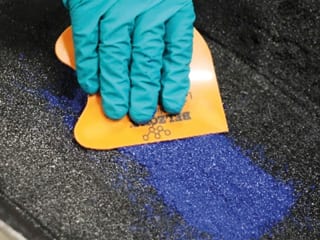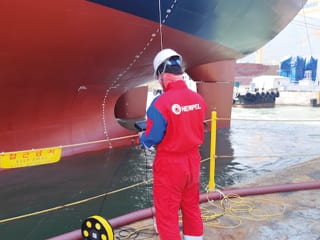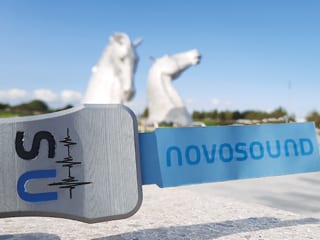Latest News
Cortec® Corporation has released an improved version of its MCI®-309 powder-based Migrating Corrosion Inhibitor™ now formulated without silica, for the protection of ferrous and aluminium metals located in recessed areas, interior cavities, and structural voids, such as post tension cable strands during the various stages of construction.
According to the company, It is an extremely efficient dry method of protecting metals within an enclosed space by simply dosing the powder into the void. Upon application, it vaporises and forms a molecular layer of corrosion inhibitors on the metal surface. If this layer is ever compromised (for example, by moisture or by opening the enclosed space), it will be automatically be replenished by new vapour being continuously released from the powder carrier. The inhibitor protects both anodic and cathodic corrosion sites of the metal, and does not contain silica, silicates, phosphates, nitrites, or heavy metals.

Latest News
Belzona Polymerics has announced the launch of a new product, Belzona 1818, specially formulated for emergency patch repairs in highly abrasive environments typically found in industries such as mining, cement, pulp and paper, biomass, where equipment is commonly exposed to extensive erosion and abrasion from excavated or processed materials of varying type, size and shape.
This product is the newest addition to the highly erosion resistant 1800 series product range and bridges the gap between surface tolerance, fast cure and high abrasion resistance. According to the company, the fast curing properties means minimal downtime for damaged equipment, so much so that the product can experience full mechanical loading and heavy abrasion just two hours after application, depending on cure temperatures. The product is supplied in convenient 1kg units where base and solidifier can be easily mixed and applied, and it offers a good working life (16 minutes at 20 C, whilst still offering fast cure and a rapid return to service.
Belzona 1818 is user friendly and can applied without the need for hot work or specialist tools. In addition, it is formulated without solvents and is free from CMR classification and labelling, whilst maintaining cure speed and performance to give a durable and long-lasting repair, concluded the company.

Latest News
Global coatings manufacturer Hempel has launched an underwater Hull Inspection service using Remote Operated Vehicles (ROVs), to provide complete hull coating inspections while a vessel is at port or anchorage. The service is being rolled out at key ports across the Asia Pacific region and will be extended to other key maritime hubs worldwide in the near future.
According to the company, inspections will be conducted by an expert Coatings Advisor operating an ROV which is navigated around the vessel’s hull using remote-controlled thrusters, with the ROV capturing high-resolution video footage and still images of the hull for assessment in real-time. Using ROVs for hull inspections simplifies the process and allows for more frequent and less costly hull inspections. As no divers are required, inspections can be conducted without the need to shut down vessel systems. This makes it possible to complete hull inspections in two hours or less even alongside cargo loading or discharge. If these inspections are combined with SHAPE, Hempel’s System for Hull and Propeller Efficiency, then they can deliver unparalleled results for better hull performance by aligning underwater visuals with existing data collection systems, concluded the company.

Latest News
Scottish technology start-up Novosound has launched a range of revolutionary non-destructive testing (NDT) products, providing a technological breakthrough that will dramatically affect how industry inspections take place.
The products, which have all been developed and produced in Scotland, can solve the issues facing the NDT market with current technology hindered by poor signal conduction, sensors unable to fit curved surfaces or unusual geometries, an inability to work at high temperatures, and the difficulties of manufacturing reliable high-resolution ultrasound probes at scale from ceramics and polymers.
The three new products, all named after Celtic legends – the Kelpie, Belenus and Nebula –can improve the way the NDT market operates across the oil and gas, renewables, and energy sectors, potentially saving companies millions of pounds in downtime.
- The Kelpie, carries out corrosion mapping or wall thickness
measurements via its innovative thin-film probes and can inspect
pipes regardless of their size or across unusually shaped
geometries
- The Belenus, a match-box sized sensor for continuous corrosion
monitoring in higher temperature enclosed environments
enables weekly data capture instead of the current annual
inspection
- The Nebula enables the continuous monitoring of results to be
remotely reported via the cloud
The Kelpies at Falkirk, Scotland.
Latest News
ISO
The following documents have obtained substantial support within the appropriate ISO technical committees during the past two months and have been submitted to the ISO member bodies for voting, or formal approval.
ISO/FDIS 8407 Corrosion of metals and alloys —Removal of corrosion products from corrosion test specimens (Revision of the 2009 standard)
ISO/DIS 11125-9 Preparation of steel substrates before application of paints and related products — Test methods for metallic blast-cleaning abrasives — Part 9: Wear testing and performance
ISO/DIS 14922 Thermal spraying — Quality requirements for manufacturers of thermal sprayed coatings —Quality assurance system (Revision of ISO 14922-1, 2, 3, and 4 1999 standards)
ISO/FDIS 21857 Petroleum, petrochemical and natural gas industries — Prevention of corrosion on pipeline system
ISO/FDIS 23123 Corrosion control engineering life cycle — General requirements
ISO/FDIS 23221 Pipeline corrosion control engineering life cycle — General requirements
ISO/FDIS 23222 Corrosion control engineering life cycle — Risk assessments influenced by stray currents
ISO/FDIS 23226 Corrosion of metals and alloys —Guidelines for the corrosion testing of metals and alloys exposed in deep-sea water
ISO/DIS 24656 Cathodic protection of offshore wind structures (See news article on page 10)
New international standards published during the past two months
ISO 1460:2020 Metallic coatings — Hot dip galvanized coatings on ferrous materials— Gravimetric determination of the mass per unit area
ISO 2409:2020 Paints and varnishes — Cross-cut Test
ISO 2810:2020 Paints and varnishes — Natural weathering of coatings — Exposure and assessment
ISO 8501-4:2020 Preparation of steel substrates before application of paints and related products — Visual assessment of surface cleanliness — Part 4: Initial surface conditions, preparation grades and flash rust grades in connection with water jetting
ISO 8502-9, 15:2020 Preparation of steel substrates before application of paints and related products — Tests for the assessment of surface cleanliness — Part 9: Field method for the conductometric determination of water-soluble salts, — Part 15: Extraction of soluble contaminants for analysis by acid extraction
ISO 11127-1, 2,3, 4, 5, and 8:2020 Preparation of steel substrates before application of paints and related products — Test methods for non-metallic blast-cleaning abrasives — Part 1: Sampling, Part 2: Determination of particle size distribution, Part 3: Determination of apparent density, Part 4: Assessment of hardness by a glass slide test, Part 5: Determination of moisture, Part 8: Field determination of water-soluble chlorides
ISO 11463:2020 Corrosion of metals and alloys —Guidelines for the evaluation of pitting corrosion
ISO 22858:2020 Corrosion of metals and alloys —Electrochemical measurements —Test method for monitoring atmospheric corrosion
ISO 23449:2020 Corrosion of metals and alloys — Multielectrode arrays for corrosion measurement
CEN
New standards published within last two months.
EN 14038-2:2020 Electrochemical realkalisation and chloride extraction treatments for reinforced concrete – Part 2: Chloride extraction
This document specifies a procedure for carrying out impressed current electrochemical chloride extraction from chloride bearing concrete in existing structures. It is applicable to atmospherically exposed parts of structures with ordinary reinforcement and/ or post-tensioned tendon ducts embedded in concrete
Previous ISO standards now issued by CEN.
EN ISO 18796-1:2020 Petroleum, petrochemicals and natural gas industries – Internal coating and lining of carbon steel process vessels – Part 1: Technical requirements (ISO 18796-1:2018)
ISO/TR 19402:2020 Paints and varnishes – Adhesion of coatings
EN ISO/TR 21555:2020 Paints and varnishes – Overview of test methods on hardness and wear resistance of coatings (ISO/TR 21555:2019)
